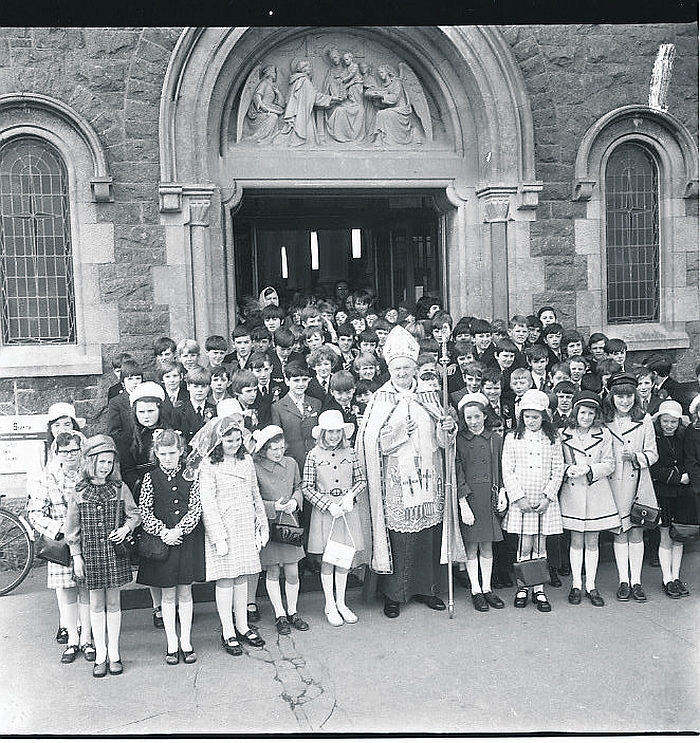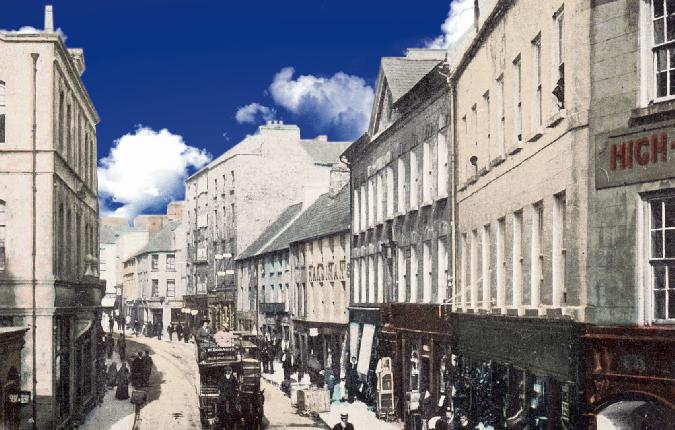Archive News
April 16, 2010

Date Published: {J}
Underage drinking
Mr PM Cahill, licensed publican, Tuam, was prosecuted by Mr O’Rorke, D.J., for permitting persons (under age) on the premises, and also for selling liquor to such persons.
A woman names Mrs O’Rourke, mother of the boy found on the premises, was also prosecuted. Mr Glynn defended.
Constable Confrey deposed that on March 5th, he observed a little boy named Thomas O’Rourke leaving Mr Cahill’s premises with a parcel under his arm. Witness asked the boy what was in the parcel, and the boy stated it was port, and the he was after getting his mother’s order. Witness obtained a certificate that the boy was not yet thirteen years of age.
Mr Glynn explained that Mr Cahill’s premises were divided, and that the front portion was allotted for the sale of provisions. To enter the bar, people had to leave the front portion and pass through a hallway.
The hardship on Mr Cahill in the case, he said, was that the young fellow’s mother was in the habit, unfortunately, of sending him for drink to bring home. He was sorry to say that the little boy was so well up that when he goes with the bottle, he leaves it in the provision department, and when taken away, he goes home.
On the occasion in question Mr. Cahill had a new assistant named Mr. Cox in the premises. They were busy in the premises, and the little fellow asked why they were not taking the bottle. Mr. Cox immediately took and filled the bottle, and gave it to the young chap, instead of having it sent up, as was formerly done by Mr Cahill’s own workman.
Chairman: It was a market day?
Mr Glynn: Yes, and it is a great hardship on Mr Cahill.
Mr O’Rorke withdrew the first charge and in the second Mr Cahill was fined 5s and costs.
In the charge against Mrs O’Rourke, her son Thomas stated that she sent him for the port and gave him the money to pay for it. He took it home to his mother. Mrs O’Rourke was fined 10s and costs.
1935
Buried alive
Two Galway labourers had a miraculous escape from living death in the early hours of Saturday morning last, when the trench in which they were working, at the entrance to the Dyke Road, Wood Quay, collapsed and buried them alive.
The two men are: Fergus Monahan,
Bohermore (widower), and Michael Hehir, Bohermore (married man). They started work on the trench at eleven o’clock on Friday night, as they were working on a night shift.
The trench, which was being dug for the purpose of laying new pipes to the waterworks, was being supervised by Mr. Alex Macdonald and his assistant, Mr. G Casserly, of Grealishtown, Bohermore, Galway.
It appears that the work was begun on the trench at 11 o’clock on Friday night. The men were digging all night, and at about 4.30am had reached the pipes. The trench by this time had reached a depth of about eight feet, and was three to four feet wide. In length it was about eight yards.
Messrs. Monahan and Hehir were standing in the bottom of the trench shovelling up the loose stone and rubble when the catastrophe occurred. The sides of the trench suddenly caved in before the horrified eyes of Mr. Macdonald and his assistant, and approximately forty tons of material buried the unfortunate men.
With great promptitude Mr. Macdonald sent for the Galway Fire Brigade, who were on the scene almost immediately. They started digging, and at first had to go very carefully, as they were afraid of hitting the buried mens’ heads. The scene was tense with emotion when, after twenty minutes’ digging, the head of the two unfortunates were uncovered.
They were, of course, unconscious, and the work of digging them out was carried on at a feverish pace. After about fifteen minutes the rescuers were able to lift them out of the trench. With all possible speed, they were rushed to the Central Hospital, Galway, where they are detained.
Mr. Alex Macdonald said that it was a horrifying experience.
“The work was proceeding without a hitch,” he said, “when suddenly the two sides of the trench caved in and the two men disappeared before my eyes. I sent for the fire brigade, and with the aid of my assistant, Mr. Casserly, immediately set about uncovering the heads of the men.
“I visited them in hospital this morning and I think they will be all right.”
On inquiry at the Central Hospital on Tuesday, a “Connacht Tribune” special representative was informed that Monahan was discharged from hospital that morning. Hehir’s condition is improving.
Trespassing sheep
A fine of 2s. 8d. and costs was imposed by Sean MacGiollarnaith, D.J., at Letterfrack district court on Stephen Walsh, Keelkyle, Letterfrack, for trespass of sixteen sheep, the property of defendant, on his land on March 23.
For more, read this week’s Connacht Tribune.
Galway in Days Gone By
The way we were – Protecting archives of our past

People’s living conditions less than 100 years ago were frightening. We have come a long way. We talk about water charges today, but back then the local District Councils were erecting pumps for local communities and the lovely town of Mountbellew, according to Council minutes, had open sewers,” says Galway County Council archivist Patria McWalter.
Patria believes we “need to take pride in our history, and we should take the same pride in our historical records as we do in our built heritage”. When you see the wealth of material in her care, this belief makes sense.
She is in charge of caring for the rich collection of administrative records owned by Galway County Council and says “these records are as much part of our history as the Rock of Cashel is. They document our lives and our ancestors’ lives. And nobody can plan for the future unless you learn from the past, what worked and what didn’t”.
Archivists and librarians are often unfairly regarded as being dry, academic types, but that’s certainly not true of Patria. Her enthusiasm is infectious as she turns the pages of several minute books from Galway’s Rural District Councils, all of them at least 100 years old.
Part of her role involved cataloguing all the records of the Councils – Ballinasloe, Clifden, Galway, Gort, Loughrea, Mountbellew, Portumna and Tuam. These records mostly consisted of minutes of various meetings.
When she was cataloguing them she realised their worth to local historians and researchers, so she decided to compile a guide to their content. The result is For the Record: The Archives of Galway’s Rural District Councils, which will be a valuable asset to anybody with an interest in history.
Many representatives on these Councils were local personalities and several were arrested during the political upheaval of the era, she explains.
And, ushering in a new era in history, women were allowed to sit on these Rural District Councils – at the time they were not allowed to sit on County Councils.
All of this information is included in Patria’s introductory essay to the attractively produced A4 size guide, which gives a glimpse into how these Rural Councils operated and the way political thinking changed in Ireland during a short 26-year period. In the early 1900s, these Councils supported Home Rule, but by 1920, they were calling for full independence and refusing to recognise the British administration.
“I love the tone,” says Patria of the minutes from meetings. “The language was very emotive.”
That was certainly true of the Gort Rural District Council. At a meeting in 1907, following riots in Dublin at the premiere of JM Synge’s play, The Playboy of the Western World the councillors’ response was vehement. They recorded their decision to “protest most emphatically against the libellous comedy, The Playboy of the Western World, that was belched forth during the past week in the Abbey Theatre, Dublin, under the fostering care of Lady Gregory and Mr Yeats. We congratulate the good people of Dublin in howling down the gross buffoonery and immoral suggestions that are scattered throughout this scandalous performance.
For more from the archives see this week’s Tribunes here
Archive News
Galway have lot to ponder in poor show

Date Published: 23-Jan-2013
SLIGO 0-9
GALWAY 1-4
FRANK FARRAGHER IN ENNISCRONE
GALWAY’S first serious examination of the 2013 season rather disturbingly ended with a rating well below the 40% pass mark at the idyllic, if rather Siberian, seaside setting of Enniscrone on Sunday last.
The defeat cost Galway a place in the FBD League Final against Leitrim and also put a fair dent on their confidence shield for the bigger tests that lie ahead in February.
There was no fluke element in this success by an understrength Sligo side and by the time Leitrim referee, Frank Flynn, sounded the final whistle, there wasn’t a perished soul in the crowd of about 500 who could question the justice of the outcome.
It is only pre-season and last Sunday’s blast of dry polar winds did remind everyone that this is far from summer football, but make no mistake about it, the match did lay down some very worrying markers for Galway following a couple of victories over below par third level college teams.
Galway did start the game quite positively, leading by four points at the end of a first quarter when they missed as much more, but when Sligo stepped up the tempo of the game in the 10 minutes before half-time, the maroon resistance crumbled with frightening rapidity.
Some of the statistics of the match make for grim perusal. Over the course of the hour, Galway only scored two points from play and they went through a 52 minute period of the match, without raising a white flag – admittedly a late rally did bring them close to a draw but that would have been very rough justice on Sligo.
Sligo were backable at 9/4 coming into this match, the odds being stretched with the ‘missing list’ on Kevin Walsh’s team sheet – Adrian Marren, Stephen Coen, Tony Taylor, Ross Donovan, David Kelly, David Maye, Johnny Davey and Eamon O’Hara, were all marked absent for a variety of reasons.
Walsh has his Sligo side well schooled in the high intensity, close quarters type of football, and the harder Galway tried to go through the short game channels, the more the home side bottled them up.
Galway badly needed to find some variety in their attacking strategy and maybe there is a lot to be said for the traditional Meath style of giving long, quick ball to a full forward line with a big target man on the edge of the square – given Paul Conroy’s prowess close to goal last season, maybe it is time to ‘settle’ on a few basics.
Defensively, Galway were reasonably solid with Gary Sice at centre back probably their best player – he was one of the few men in maroon to deliver decent long ball deep into the attacking zone – while Finian Hanley, Conor Costello and Gary O’Donnell also kept things tight.
For more, read this week’s Connacht Tribune.
Archive News
Real Galway flavour to intermediate club hurling battle in Birr

Date Published: 23-Jan-2013
images/files/images/x3_Courthouse.jpg










